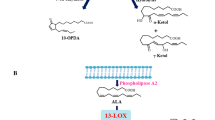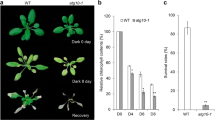Abstract
A new method has been developed to assay poly(ADP-ribose) polymerase (PARP) activity in plant tissues through determining the content of nicotinamide (NIC) produced by enzymatic reaction by linear sweeping polarographic method. The detection limit of NIC was 0.03 μmol/L, the calibration graph was linear up to 5 μmol/L (r = 0.999). The recoveries were approximately in the range of 92% to 98% and the relative standard deviations were less than 6.6%. Moreover, NAD+ and other interference existing in the mixture after enzymatic reaction had been removed by simple pretreatment, thus PARP assays were not interfered. A rapid, simple, sensitive and reliable nonisotopic method is reported to assay PARP activity in plant tissues. The results show that the KmNAD value of PARP in maize (Zea mays L.) seedlings is 59 and the optimum pH for PARP activity is 8.5. Moreover, physiological conditions affect PARP activity in plant tissues. which has not been reported previously. When tobacco (Nicotiana tobacum) suspension cells were stressed by NaCl at low concentrations (100, 200 mmol/ L), the PARP activity increased significantly; when the cells were stressed at high concentrations (400, 1 000 mmol/L), it decreased to or even below the control level. PARP activity in etiolated maize seedlings was higher than that in light-grown seedlings.
Similar content being viewed by others
References
Wood, R.D., DNA repair in eukqotrs,Annu. Rev. Riochem., 1996, 65: 135
Lindahl, T., Satoh, M. S., Poirier, G. G.et al., Post-translational modification of poly(ADP-ribose)plymerase induced by DVA strand breaks,Trend Biochem. Sci., 1995, 20: 405.
Mristerernst, M., Steizer, G., Roeder, R. G., Poly(ADP-ribose) polymaraae enhances activator-dependent transcriptionin vitro, Proc. Natl. Acad. Sci. USA, 1997, 94: 2261.
Smulsnn, M.E., Kang, V.H., Ntambi, J.M.et al., Requirement for the expression of poly(ADP-ribose) polymerase during the early stages of differentiation of 3T3-L1 preadopocytes, as studied by antisense RNA induction,J. Biol. Chem., 1995, 270: 119.
Burglund, T., Nicotinamide, a missing link in the early stress response in eukaryotic cells: a hypothesis with special response to oxidative stress in plants,FEBS Lett., 1994, 351: 145.
Lazebnik, Y. A., Kaufmann, S. H., Desnoyers, S.et al., Cleavage of poly (ADP-ribose) polymerase by a proteinase with properties like ICE,Nature, 1994, 371: 346.
Tewari, M., Quan, L.T., Rourke, K.et al., Yama/cpp32β, a mammalian homolog of ced-3 is a cramA-inhibitahle protease that cleaves the death substrate. poly(ADP-ribose) polymerase,Cell, 1995, 81: 801.
Chen, Y. M., Shall, S., O’Farren, M., Poly(ADP-ribose) polymerase in plant nuclei,Eur. J. Biochem., 1994, 224: 135.
Shah, G.M., Poirier, D., Duchaine, C.et al., Methods for biochemical study of poly(ADP-ribose) metabolismin vitro andin vivo, Anal. Biochem., 1995, 227: l.
Balschukat, D., Kress, E., Use of column switching for the determination of niacinamide in compound feed,J. Chromatogr., 1990, 502: 79.
Sperling, A., Determination of heroin and some common adulterants hy capillary gas chromatogaphy,J. Chromatogr., 1991, 538: 269.
Zanycki, P.K., Kowalaki, P., Nowakowska, J.et al., High-performance liquid chromatographic and capillary elwtrophoretic determination of free nicotinic acid in human plasma and separation of its metabolites by rapillay e1ectrophoresis.I. Chromatogr., 1995. 709: 203.
Guilfoyle, T. J., Isolation and characterization of plant nuclei,Methods Cell Biol., 1995, 50: 101.
Evens, D. L., Dive, C., Effect of cisplatin on the induction of apoptosis in proliferating hepatoma cells and nunproliferating immature thymytes,Cancer Res., 1993, 53: 2133.
Weis, M., Kass, G. E. N., Omnius, S.et al., N-aretyl-p-benzoquinone imine induces ca2+ release from mitochondria by stimulating pyridine nucleotide hydrolysis,J. Biol. Chem., 1992, 267: 804.
Karasawa, T., Takasawa, S., Yamakawa, K.et al., NAD-glycohydrolase fromStreptococcus pyogenes shows cyclic ADP-ribose forming activity,FEMS Micro. Lett. 1995, 130: 201.
Alvarezgonzalez, R., Deoxynacl and deoxyarlp-ribosylation of proteinn,Mol. Cell Biochern., 1994, 138: 213.
Author information
Authors and Affiliations
About this article
Cite this article
Tian, R., Chen, D. & Dai, Y. Assaying poly(ADP-ribose) polymerase activity in plants by polarographic method. Chin. Sci. Bull. 44, 1883–1887 (1999). https://doi.org/10.1007/BF02886346
Received:
Issue Date:
DOI: https://doi.org/10.1007/BF02886346




